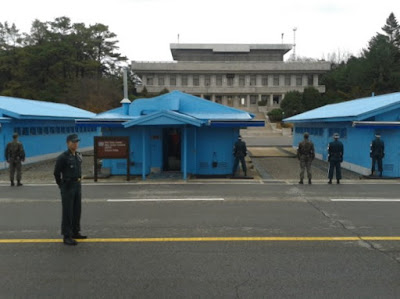The DMZ is the area extending two kilometers to either side of the border between the North and the South. It is one of the most heavily militarised zones in the world right now but interestingly enough, the entire line is only marked by small singular white posts. Inside the DMZ there is a mixture of farm land, wildlife and it is even home to (as they like to call it) ‘The Most Dangerous Golf Course in the world’ which is surrounded by live landmines left over from the Korean war. The most fascinating thing of all though, is that this area has completely reverted back to nature. It is one of the most undeveloped areas in Asia that is home to an immense amount of plant and animal life. It is even speculated that the rare Siberian Tiger (The traditional symbol of unified Korea) is among the wildlife here, although this is yet to be proven.
Joint Security Area
One of our first stops along the DMZ was the applicably named 'Third Tunnel of Aggression'. Buried deep beneath the DMZ are 4 small tunnels that were discovered in the 70's, and were built by North Korea to invade the South, although they will of course deny this. The third tunnel is extremely small as the average height of a North Korean man is just 5 foot 5 inches, so most people do have to crouch down the entire way. Luckily for me and all of my 5 foot and 1 inch - it didn't cause too much of a problem. Once inside and after a less than comfortable ride down to the bottom on a small monorail (claustrophobics beware), you can see black markings all along both sides of the walls. These were apparently painted on by the North, to suggest that they were simply just digging for coal, should their tunnels ever be found. However, there has never been any evidence to suggest that coal has ever existed in these granite dug tunnels, so it is a little bit awkward for them.
Safety First!
The end of the tunnel!
DMZ!
We also passed The Bridge of No Return - a prisoner exchange bridge between the two sides, and the Freedom Bridge, which was used to send soldiers back from the North during the war. Both bridges are now of course completely inaccessible. After presenting our passports at about 5 different check points throughout the day, we finally reached the last one. Here, a soldier boarded the bus and did a final check of our identification, and also our outfits. The dress code (along with everything else) is quite strict and you are told beforehand of what not to wear. This consisted of no sleeveless or collarless shirts, no army related clothing, and no flags from anywhere whatsoever. It was pretty crazy, and we were told by our guide at least 20 times an hour not to take any pictures in certain spots, and NEVER to point.
North Korea
Messages left by separated families on the Freedom Bridge
When we arrived at the JSA we were also told not to drink water or make any sudden movements. We all entered in 2 straight lines passing soldiers on either side as silence filled the air. We were able to go into the meeting room and step over the border itself meaning that technically we were in North Korea, and we were funnily enough allowed to take pictures in this part. Shortly before this and still standing in line, we were given a moment to stop, and take it all in. As I looked out towards North Korea which was only a few steps away, I felt very strange. I'm not sure if I was scared, or worried, or just emotional about all of the history that these two sides have shared together, but it was a feeling that I will never forget.
The guards at the JSA
The Meeting room - South on the left, North on the right!
Over the border in North Korea!
You will not regret it!










No comments:
Post a Comment